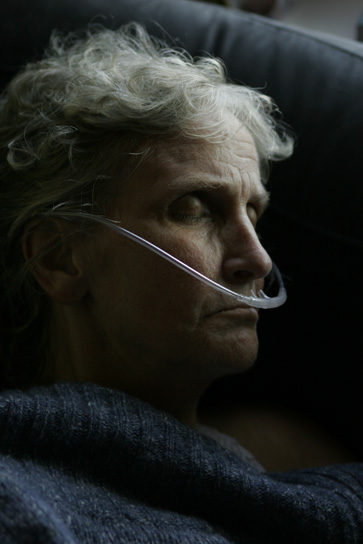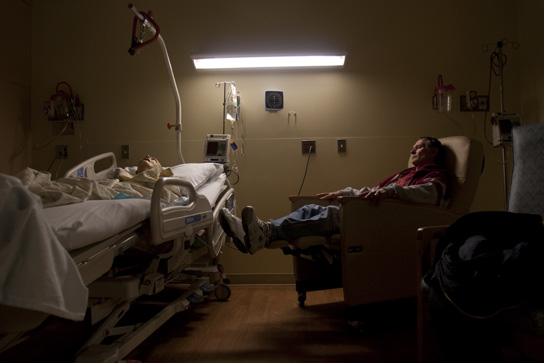 Logan Mock-Bunting photographed a story about his mother. Her favorite holiday was Christmas. © Logan Mock-Bunting
Logan Mock-Bunting photographed a story about his mother. Her favorite holiday was Christmas. © Logan Mock-Bunting
This is the first in a series of pieces about long term bodies of work that people I work with are working on.
Making pictures of people you care about is one thing. Making pictures of your parent is another. If photographs reflect the essence of the person who made them, then by extension, photographs you make of your mom or dad say a lot about your relationship to them.
To photograph your parents, you have to raise your camera through the whole of the history you have with them and confront all that your life has been, as it relates to them.
And so it was that I spent much of last week with tears on my face as I looked at several hundred photographs that Logan Mock-Bunting made of his mother.
It took a special kind of courage for Logan to make these pictures. You see, for more than four years he photographed his mother’s serpentine path to what became her death, as her body succumbed to cancer.
He was there as his mom explained to her husband where the tumor is, after she first learned she had cancer. And he was there, with camera raised, for the myriad of medical procedures and moments she had alone to contemplate the enormity of what she faced. And he was there to make photographs that show how much his dad cared for his mom and how uplifting family gatherings and meeting just-born nephews and walks on the beach and last vacations and time spent with friends meant to her.
 Logan talked about how hard it was to make pictures as the disease progressed. © Logan Mock-Bunting
Logan talked about how hard it was to make pictures as the disease progressed. © Logan Mock-Bunting
Logan was there. For it all.
I asked him questions for this post. The first was, how did you decide to make pictures of your mom’s battle with cancer:
“Mom called me a few years ago and asked me to come over - she specifically told me to bring my camera. I'd been a photojournalist for about 5 years, and she loved talking to me about story ideas, so I figured it was simply another idea (or maybe a pretty flower in the garden).
Instead, that afternoon she told my father and me that she had a tumor in her lung. She asked if I wanted to photograph her journey. She didn't want to call it a battle or a fight - those words were too violent for her. She considered it a journey because she wanted to survive, as well as embrace the joy of life with what time she had.
And so we began a project together. The next five years we spent documenting her life, loves, and ultimately her passing.”
What was it like to make these pictures?
“I don't know what to say. Sometimes it was difficult to hit the shutter when it felt like I should be more in the son role than the observer role. Many times I didn’t make a photo because it didn't feel right. Sometimes the only way I got through situations was being able to put the camera over my face like a mask, look through the barrier and think about light and composition instead of what was going on to my family around me. It ran the spectrum.”
How were you able to spend so much time on the story?
“I made the time. I'm freelance, and I made it a priority to be with Mom and Dad. I have just recently started to shift away from my hometown (I'm now working in Washington DC) but that wasn't an option for me when Mom was sick - I wasn't going to move away. It was not easy and it meant lots of driving to Dr's appointments, lots of sitting, waiting and crying. But it was something I had to do.”
Why did you make these photographs?
“What else was I going to do? I was physically helping my family as much as I could. I was emotionally doing all I could for them. But there is still an amazing sense of helplessness when you are watching a family member die from within. Photography was a way to literally organize things, to process them and have a little control over something. It was a therapy, a guard, a protection and a mission. When everything else is up in the air, it can be nice to have a purpose to guide your next action. I would love it if this work could help someone else get through the mourning process, or help someone feel less isolated by sharing the experience - but at the time, I was making them because I needed to (and I knew I had my family's blessing to do so).”
We’re working on an edit and probably a book design with Cococello. It’s such a rewarding experience to be associated with Logan and in turn, his mom.
How do you know how to tell a story like this one, if you embarked tomorrow without knowing the path it would take? And how do you go beyond making it a process story, one that simply shows the steps of the path?
The answer to both of these questions is similar to the question of how you make a single photograph of a single occurrence go beyond showing what happened.
You first have to invest yourself in the subject matter - even in Logan’s story where he certainly knew his mother, there were questions to ask, things to learn. Information tells you when to be there to make pictures.
Once there, in the right situations, strive to make pictures that go beyond the informational aspects of what’s happening. Rather, convey the qualities of what is happening. Before you raise your camera, know what you want to say about what’s going on.
Another way of saying this is that you should have some sense of what people who look at your pictures from a given setting will feel, what response will your pictures elicit.
So in the moment, you should be able to express a quality - hope, isolation, support, joy, burden, release ... - that is unique to the setting. Set out to make a photograph that makes people feel what you think the scene is about, not at the what’s happening level but at the emotive or qualitative level.
As you chose to photograph a range of situations that represent the range of what a subject is going through, edit the work and elevate the most successful images so you know what the photographs you’ve made convey. Try not to hit the same note, convey the same quality, over and over unless that is the essence of what’s happening. And if there is repetition, strive to photograph each occurrence in a way that brings new understanding to the setting and what the person is facing.
Over time, as your body of work builds you should have an overall sense of the major themes of the photographs and you should make sure that each of those themes is fully developed. Logan said that he wished he had concentrated more on making photographs of his father.
Stories you’re telling about individuals can be like an onion. You chose to photograph only the center layer but there are layers outside the middle that can be just as compelling. Rob Finch once did a compelling story about how a mother dealt with the disease her son eventually died from, for instance.
So by building a body of work wherein each thing you photograph is dimensional and being aware of the range of what the subject is about and making pictures, as appropriate, of the layers around the subject you are producing a set of pictures that allow a dynamic story line to emerge.
The shooting part of this kind of story, where you don’t know what will happen in the end, is a bit like making a movie. You may well have a sense of things that will happen from the outset, there is a script of sorts. But things you photograph may or may not end up in the final cut. The movie evolves in the editing stage largely based on how successful you were in shooting each scene and which of those scenes thread together to tell a compelling story.
The path is never certain but the goal in making photographs along the path should be clear so that whatever happens in the end, you can touch people with your pictures. Logan did this. And I wept.
 These were the last moments Logan and his dad spent with his mom. © Logan Mock-Bunting
These were the last moments Logan and his dad spent with his mom. © Logan Mock-Bunting
